Part of a series of articles titled Alaska Park Science, Volume 18, Issue 1, Understanding and Preparing for Alaska's Geohazards.
Article
Volcanic Hazards in Alaska’s National Parks

Photo courtesy of Matt Loewen, USGS/AVO, on August 15, 2018. AVO image ID 118571
There are over 100 volcanoes in Alaska, 54 of which are considered historically active. A historically active volcano is one that fits one of the following criteria: (1) a documented or strongly suspected eruption since the year 1700, (2) persistent fumaroles near boiling point, (3) significant deformation with a volcanic cause, or (4) an earthquake swarm with a volcanic cause (Cameron and Schaefer 2016). Alaska’s national parks, preserves, and monuments contain a total of 14 historically active volcanoes (Figure 1). In addition, there are numerous other volcanoes within Alaska’s parks that are not considered historically active, but which could erupt at some point in the future.
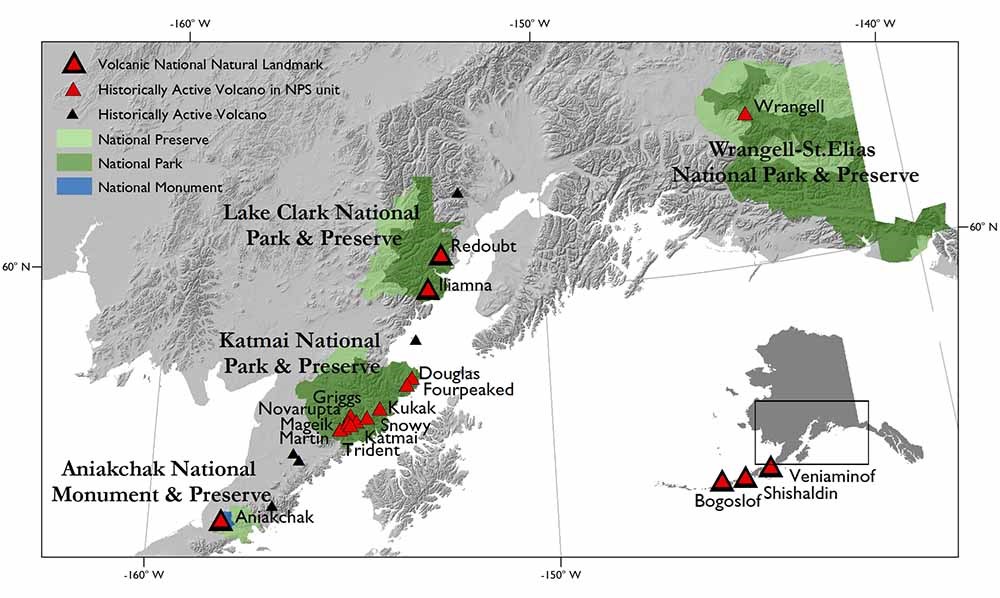
In the past 100 years, there have been seven confirmed eruptions from historically active volcanoes within Alaska’s parks. The Alaska Volcano Observatory (AVO) monitors and conducts research on volcanoes in Alaska in order to better understand volcanic processes and determine the likelihood of future volcanic hazards, with a primary goal of informing the public and local, state, and federal entities about volcanic hazards and impending volcanic activity. Volcanic hazards in Alaska’s parks include both proximal hazards (within 19 miles [30 km] of the vent) and distal hazards that are capable of impacting areas at the regional, national, or international scale.
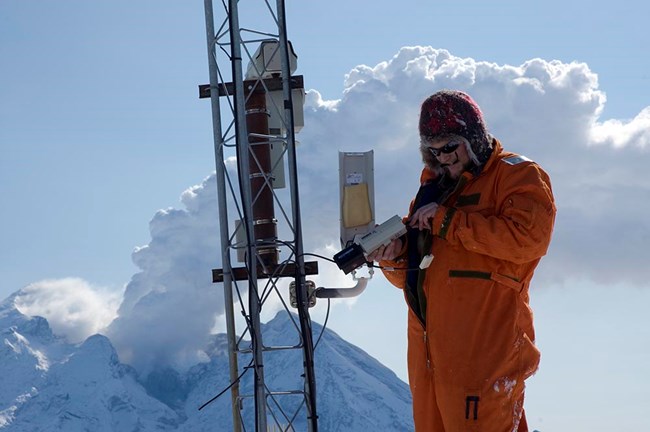
The Alaska Volcano Observatory: Assessing Volcanic Hazards in Alaska
AVO conducts geologic studies to better characterize past volcanic activity and inform on the likely effects and hazards of future eruptions. As products of this work, AVO publishes research articles, reports, geologic maps, and hazard assessments. Much of this material is available to the public on the AVO website, which provides information on past and current activity at volcanoes in Alaska.
AVO monitors volcanoes in Alaska via a network of instruments including seismometers, global positioning system (GPS) stations, web cameras, and infrasound sensors that telemeter real-time data to observatory staff (Figures 2 and 3). Daily review of satellite imagery and annual or opportunistic overflights to measure gas emissions complement the real-time monitoring data and new technologies and tools, such as lightning detection, which can indicate the presence of volcanic plumes, are continually being developed and used to better detect volcanic activity. Occasionally, there are false reports of volcanic activity, especially regarding Mount Wrangell and Iliamna Volcano, which AVO can authoritatively confirm as “non-eruptions” by checking for changes in these real-time monitoring data.

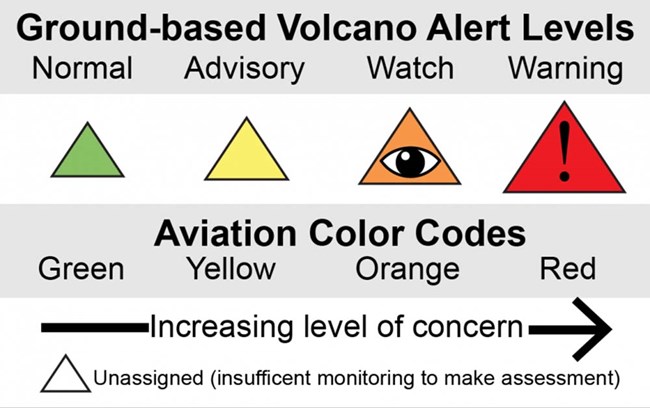
In the United States, a standardized volcano alert system is used to assign monitored volcanoes an Alert Level and Aviation Color Code, both of which convey a volcano’s level of activity and presence of potentially hazardous conditions on the ground or in the air (Figure 4; Gardner and Guffanti 2006). Changes observed in the monitoring data of a volcano, such as an earthquake swarm, may merit a change in its Alert Level and Aviation Color Code and such a change is communicated to the public via the AVO website, social media and news outlets, and the Volcanic Activity Notification Service.
During an eruption, AVO responds as appropriate by increasing the number of field instruments, the frequency of review of monitoring data streams, and communication of hazards information to other government agencies, affected industries, and the general public (Neal et al. 2010). AVO’s responsibility is to detect signs of volcanic unrest and report that information along with potential volcanic hazards; however, other state and federal agencies, including the Federal Aviation Administration (FAA), the National Weather Service (NWS), and the Alaska Department of Homeland Security and Emergency Management, also have reporting responsibilities related to volcanic activity. The Alaska Interagency Operating Plan for Volcanic Ash Episodes (AVO et al. 2017) enables rapid and efficient communication of volcanic hazards by outlining the specific roles and responsibilities of each agency during a volcanic crisis.
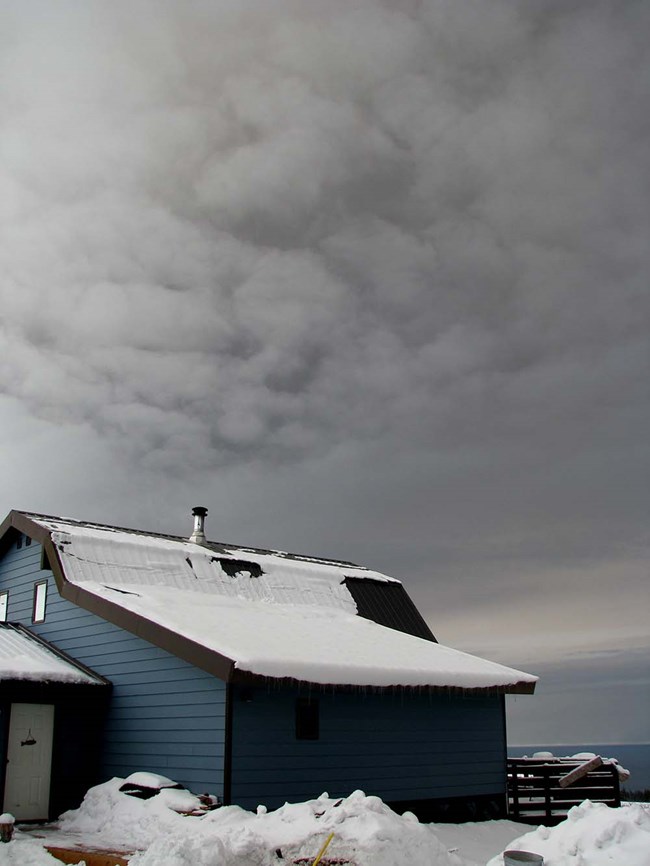
Photo courtesy of Dennis Anderson, AVO image ID 17091
Volcanic Hazards in Alaska
Due to the remote location of many of the volcanoes in Alaska, the volcanic hazards that are of the greatest concern typically are those with the potential to affect distal areas. These hazards are often aviation-oriented and primarily include drifting ash clouds and ashfall. Volcanic hazards within Alaska’s parks also include proximal hazards that could be of concern to employees and visitors.
Distal Volcanic Hazards
Because volcanic ash is so readily transported, parks in Alaska may be affected by ash clouds or ashfall from volcanic eruptions that occur both within and outside of their boundaries. Ash clouds are formed when an explosive eruption energetically fragments magma, rapidly injecting small particles (ash) into the atmosphere, sometimes to heights of greater than 32,000–65,600 ft (10–20 km) above the volcano within less than an hour (Figure 5). Ash is highly abrasive and the particles can severely damage aircraft, eroding and adhering to engine and electrical parts and abrading windows, wings, and landing gear. Electrical disturbances and gases within an ash cloud may impair the aircraft’s ability to transmit messages and cause respiratory problems for those on board. Many visitors to Alaska’s parks arrive via small aircraft that typically travel at altitudes where volcanic ash is most likely to be present (10,000–20,000 feet [3–6 km] above sea level). Thus, sustained ash emissions during summer, by volcanoes erupting within or outside of parks, could significantly curtail or inhibit access to parklands. Flight cancellations and delays could significantly impact passengers and cargo.
Ash fallout can occur in both proximal and distal locations relative to the volcanic vent that is erupting. Typically, larger particles (which are heavier) are deposited closer to the vent, whereas smaller particles are suspended in the air for longer and thus may be transported farther from the vent prior to being deposited. Trace ashfall (<1/32 of an inch) is common in distal areas and typically causes low-level impacts such as eye and respiratory irritation. However, greater amounts of ashfall accumulation may adversely impact plants and animals and cause problems for infrastructure. Wet ash is significantly denser than dry ash and if significant amounts accumulate on buildings, structural failure may result. Thick accumulations of volcanic ash can make roads impassable, degrade surface and drinking water supplies, and interfere with communication systems.
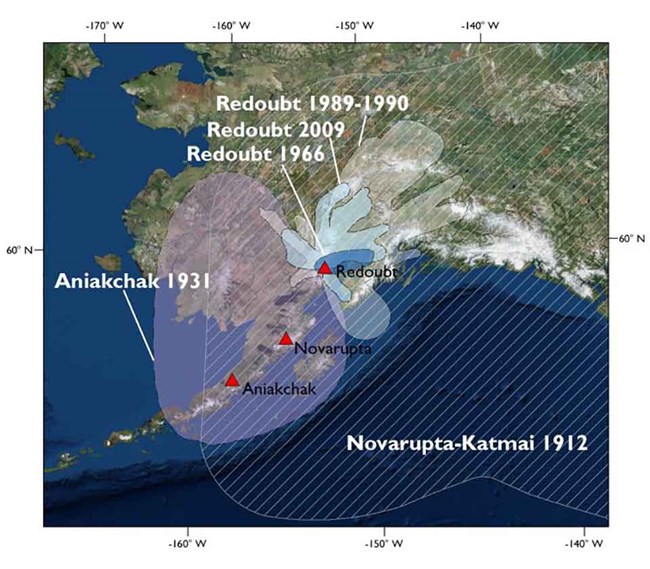
Multiple historical eruptions of volcanoes located within Alaska’s parks have produced ash clouds and resulted in ashfall that affected and sometimes continue to affect large areas beyond their boundaries (Figure 6). Ash from the 1912 eruption of Novarupta-Katmai, which was the most voluminous of the twentieth century (Hildreth and Fierstein 2012), poses an ongoing seasonal hazard due to resuspension during very high winds and dry conditions (see Wallace and Schwaiger, this volume). The 1931 eruption of Aniakchak volcano resulted in millimeters of ashfall as far as Kodiak Island (Bacon et al. 2014). During the 1989-1990 eruption of Redoubt Volcano, multiple jetliners encountered the ash cloud, in one case as far away as Texas (Casadevall 1994). A 747-400 jet aircraft inadvertently flew through the 1989-1990 Redoubt ash cloud near Anchorage and temporarily lost power in all four engines. Although the plane landed safely, it incurred $80 million in damages. This event led to the expansion of AVO and remains an important example of the need for vigorous volcano monitoring and hazard communication (Guffanti et al. 2010).
Proximal Volcanic Hazards
Proximal hazards include ballistics, lahars, pyroclastic flows, lava flows and domes, rockfalls, landslides, debris avalanches, and volcanic gases.
Ballistics
Ballistics are volcanic bombs of pebble- to boulder-sized clasts that are ejected explosively from the volcano during an eruption and typically deposited within a few kilometers of the vent. Ballistic fallout can cause damage and injury to people and structures in the fallout zone.
Lahars
Lahar is an Indonesian word for a flowing mixture of water, rock debris, and mud on a volcano. Lahars can be hot or cold and can consist of material ranging in size from boulders to fine sediment. Typically, lahars have the consistency of wet concrete and can flow along valley floors many tens of kilometers from their volcanic sources. Lahars at volcanoes in Alaska typically occur during volcanic eruptions due to the interaction of hot volcanic debris with ice and snow. The AVO hazard assessments for many of the volcanoes within Alaska’s parks show the extent of lahar inundation in river valleys likely to be affected by lahars. Lahars may also be generated during non-eruptive times due to heavy rainfalls that saturate unconsolidated deposits on steep slopes.
During the 2009 eruption of Redoubt Volcano, lahars traveled more than 25 miles (40 km) down the Drift River valley and inundated parts of the Drift River Oil Terminal, resulting in emergency evacuation of personnel and eventually cessation of terminal operations (Schaefer 2012; Figure 7). The Drift River Oil Terminal area also experienced lahars during the 1989-1990 and 1966-1968 eruptions of Redoubt.
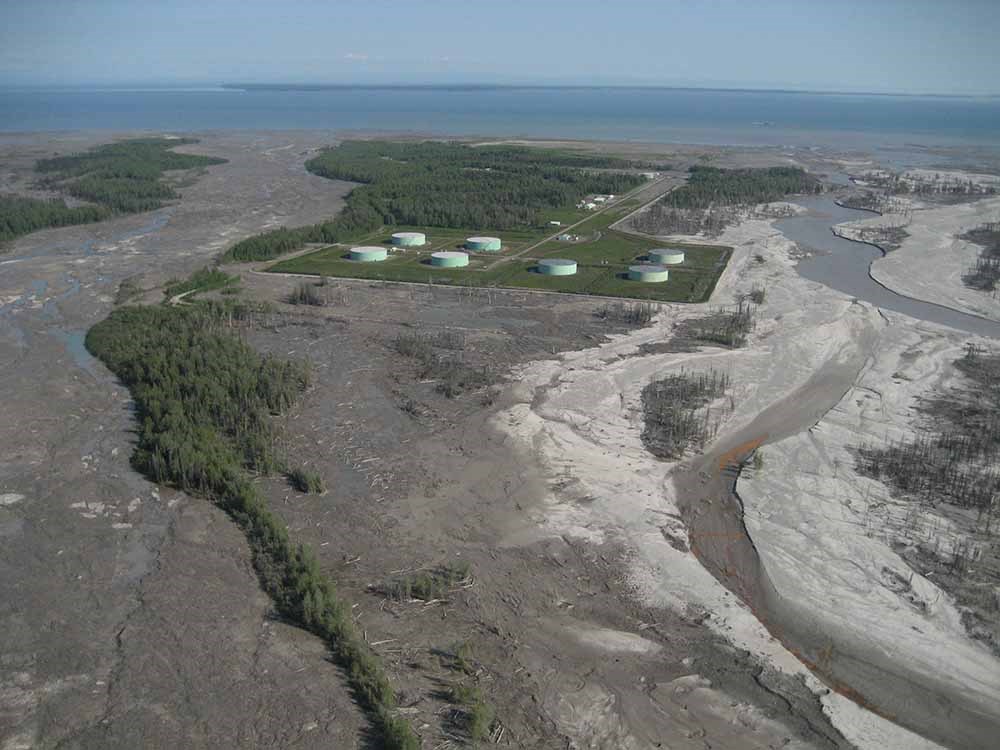
Image taken by Max Kaufman on June 8, 2009 and courtesy of the AVO/UAF-GI, AVO image ID 19402
Pyroclastic Flows and Surges
Pyroclastic flows are hot, turbulent mixtures of gas and rock debris that travel downslope during explosive volcanic eruptions. Pyroclastic flows may form when a lava dome or eruption column collapses and may travel more than 19 miles (30 km) from the source vent. Pyroclastic surges are similar to flows, but contain more gas. Pyroclastic flows and surges are generally confined by existing streams and drainages, but also may travel over topographic features. Eruptions of Redoubt in 1989-1990 and 2009 produced pyroclastic flows that moved down the Drift glacier gorge and eroded and melted glacier ice that contributed large amounts of water to the valley floor that resulted in lahar generation (Figure 8). Pyroclastic flows produced during the 1912 eruption of Katmai-Novarupta, the largest eruption in the world during the 20th Century, include approximately 2.6 cubic miles (11 cubic kilometers) of pyroclastic material that filled nearby valleys (Fierstein and Hildreth 1992). This deposit, one of the most spectacular examples of such deposits on Earth, is known today as the Valley of Ten Thousand Smokes.
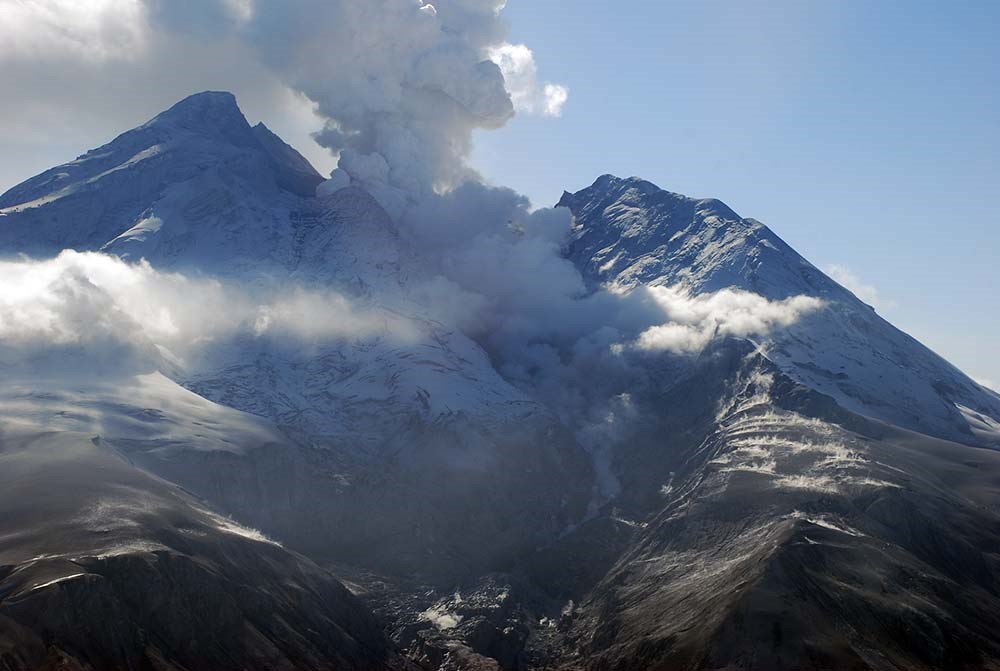
Image taken by K.F. Bull, April 4, 2009 and courtesy of AVO/USGS, AVO image ID 47211
Lava Flows and Domes
Due to their composition, lava flows in Alaska typically travel slowly and therefore are an avoidable hazard. Some lava flows in Alaska are associated with sustained lava fountaining whereby fountain-fed lava flows develop and may extend several kilometers down the flank of the volcano. When lava flows interact with water or ice, additional hazards may include explosions and ballistic production. Lava domes are viscous, plug-like masses of lava that form at the top of a volcanic conduit (Figure 9). Lava domes may become unstable and susceptible to collapse, resulting in the formation of a type of pyroclastic flow called a block and ash flow that can travel several kilometers and be quite hazardous.
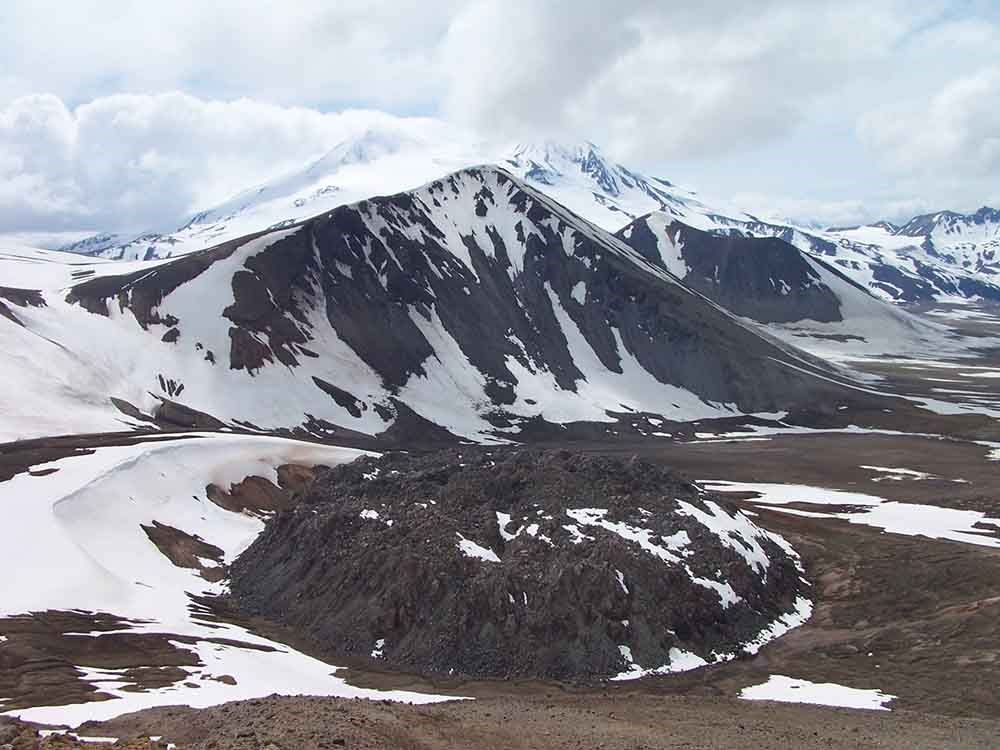
Image taken by Pavel Izbekov, courtesy of AVO/UAF-GI. AVO image ID 14207
Volcanic eruptions in Alaska parks have produced lava flows and domes at several locations. Typically, a lava flow poses no hazard to people as it is possible to walk away from an advancing lava flow without harm. In the unlikely event that a person was near an actively growing lava dome, this could pose a more substantial hazard because of the possibility for gravitational collapse and the formation of block and ash flows. Additionally, lava flows advancing over snowfields can cause unstable ground conditions due to surface and subsurface melting. These processes can happen quickly and typically there would not be sufficient time for a person to move to a safer location.
Eruptions of Redoubt Volcano, Mount Veniaminof, and several volcanoes within the Katmai cluster have generated lava flows during historical eruptions. Some of these lava flows interacted with glacier ice, such as during the 2013 eruption of Mount Veniaminof, where lava flowed over glacier ice and snow within the ice-filled caldera, producing voluminous steam and melting a small ice cauldron in the glacier (Figure 10; Dixon et al. 2015).
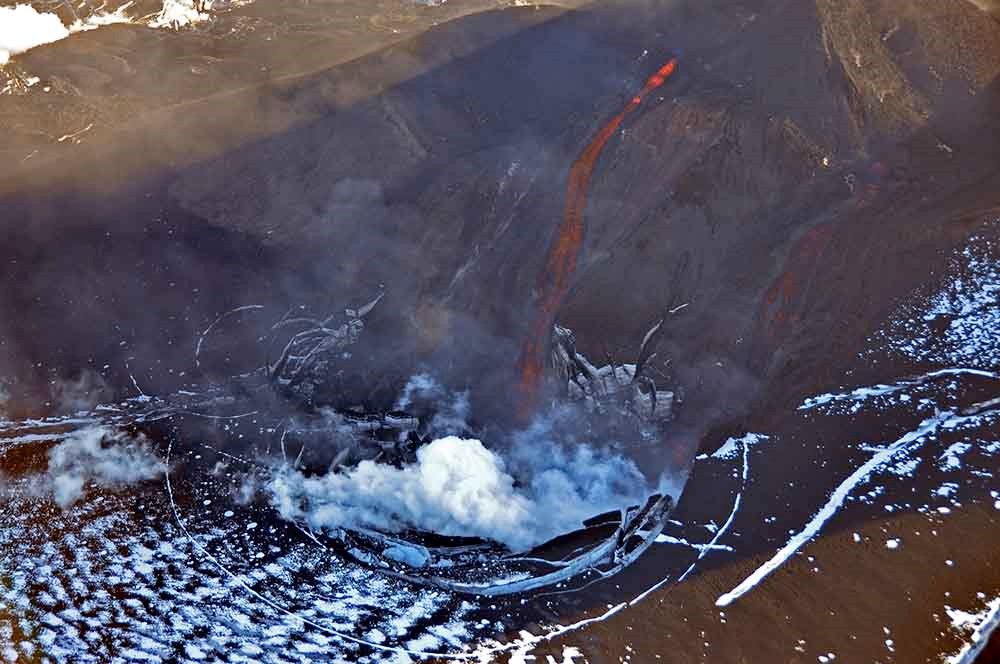
Photo taken on August 19, 2013 by Game McGimsey, AVO/USGS during an overflight co-sponsored by the National Geographic Society. AVO image ID 54781
Mass Movement: Rockfalls, Landslides, and Debris Avalanches
Because volcanoes are constructed of fragmental volcanic material that is poorly consolidated and often very altered, they are somewhat unstable and may be susceptible to mass movement. Whereas a rockfall is a localized event that may not impact a large area, landslides involve mobilization of loose material over a larger range of surface areas, and debris avalanches involve massive collapses of parts of a volcanic edifice.
Rockfall and landslide hazards are an ongoing concern to park visitors in all locations with steep volcanic terrain and high relief. Large landslides can be triggered by tectonic earthquakes especially in landslide-prone areas where they have happened previously. Large flank-collapse debris avalanches are generally uncommon, although most volcanoes experience one or two large flank failures in their life history, typically associated with other types of volcanic unrest or eruptive activity. At Iliamna Volcano, small volume rockfalls and landslides are occasionally observed and are typically associated with an area of persistent fumarolic activity on the upper southeast flank of the volcano (Figure 11). Small rock-ice-snow avalanches are also common on the upper edifice of Redoubt Volcano, but are usually confined to the summit crater area.
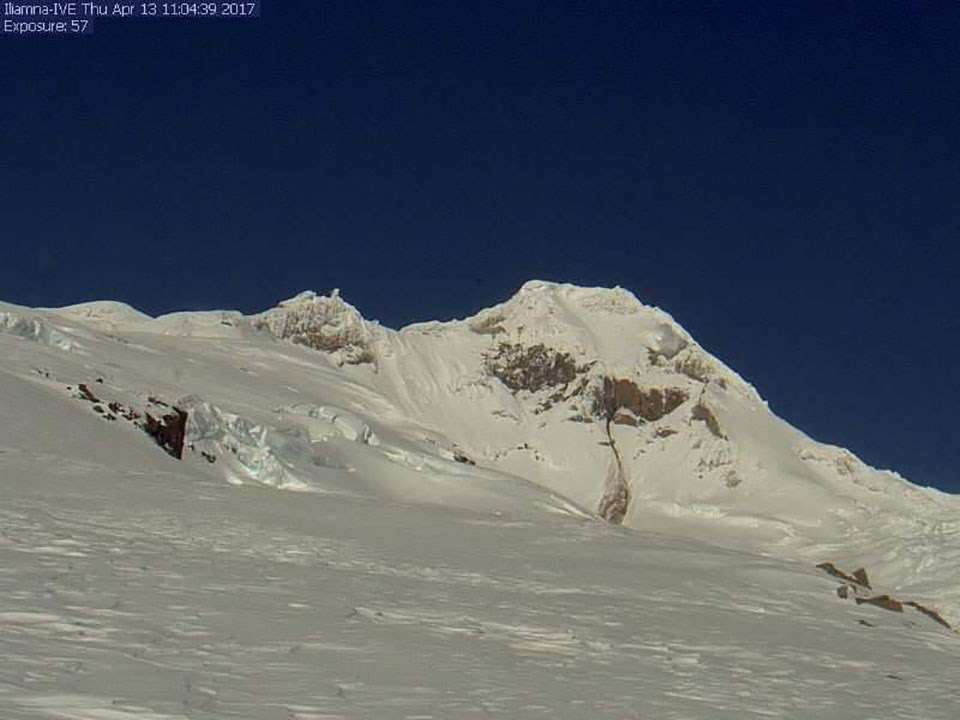
Volcanic Gases
The magma that fuels volcanic eruptions contains dissolved gases. Volcanic gases are released from the magma during eruptions, but can also be passively released when the volcano is not erupting. Typical volcanic gases include water vapor, carbon dioxide, sulfur dioxide, hydrogen sulfide, hydrogen, and fluorine (Myers et al. 2008). When a volcano degases passively, it does so via fumaroles and cracks in the volcanic edifice. Volcanic gases may irritate respiratory systems and eyes for those that are close to the vent area; gases may combine with water in the atmosphere, forming acid rain that damages plants and can impact animals and infrastructure. Because carbon dioxide is heavier than air, it may collect in low-lying areas thereby displacing oxygen making normal respiration difficult or impossible. Volcanic gases released into bodies of water create an acidic environment that is toxic to plant and animal life.
Volcanic gases emitted by active volcanoes within Alaska parks are typically not hazardous because many of the vents lack suitable topography that facilitates trapping of gases. Also, the frequent windy conditions at most volcanoes disperse volcanic gas and inhibits build up to toxic levels. Nevertheless, actively degassing areas within craters have the potential to collect gas and fumarolic areas on the flanks. This may lead to unstable ground conditions and such areas should be avoided. Occasionally, volcanic gas emissions can develop suddenly at unexpected locations on volcanoes. For example, Fourpeaked Mountain was not considered an historically active volcano until 2006, when steam explosions (also called phreatic explosions), sulfur compounds, and particulate emissions heralded the onset of fumarolic activity near the glacier-clad summit (Figure 12; Neal et al. 2009). In the western part of Wrangell-St. Elias National Park and Preserve near Glennallen, there are two areas bounding faults where carbon dioxide-charged warm saline water is issuing through ancient lake sediments at the surface creating mud volcanoes informally called the Tolsona and Klawasi group. Park visitors in areas of the mud volcanoes also risk exposure to volcanic gases.
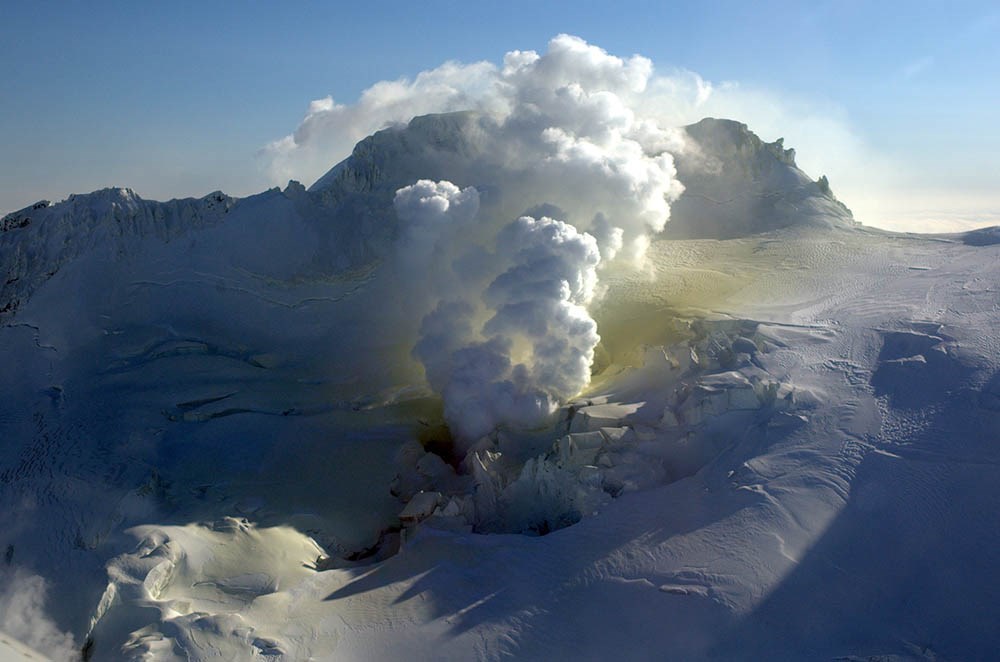
Image taken on February 22, 2007 by Cyrus Read, courtesy of AVO/USGS. AVO image ID 13141.
Conclusion
AVO is responsible for monitoring, conducting research, and evaluating the hazards of volcanoes in Alaska, which includes the 14 historically active volcanoes within national parks, preserves, and monuments. As such, AVO relies on National Park Service support in enabling field operations, which encompasses monitoring station maintenance, geologic investigations, and eruption response. AVO maintains inter-agency relationships to allow for rapid communication of information regarding volcanic events, with the goal of protecting the public, including park personnel and visitors, from harm. Multiple volcanic hazards exist within park boundaries, including ash clouds, tephra fall, volcanic gases, pyroclastic flows and surges, lava flows, and mass movements such as rockfalls and landslides. As park personnel and visitors are made aware of the types of volcanic hazards, they can better know how to avoid them. One step toward increasing awareness of volcanic hazards within Alaska’s national parks, preserves, and monuments is to encourage park personnel and visitors to familiarize themselves with the volcano alert system and to subscribe to the Volcanic Activity Notification service. In addition, park personnel and visitors should always be aware of the Alert Level and Aviation Color Code for those volcanoes in their vicinity.
References
Alaska Volcano Observatory, National Weather Service, Federal Aviation Administration, Department of Defense, United States Coast Guard, Division of Homeland Security and Emergency Management, Alaska Department of Environmental Conservation, and Alaska Department of Health and Social Services (participating agencies). 2017.
Alaska interagency operating plan for volcanic ash episodes, 49 p.
Bacon, C. R., C. A. Neal, T. P. Miller, R. G. McGimsey, and C. J. Nye. 2014.
Postglacial eruptive history, geochemistry, and recent seismicity of Aniakchak volcano, Alaska Peninsula. U.S. Geological Survey Professional Paper 1810, 74 p., http://dx.doi.org/10.3133/pp1810
Cameron, C. E. and J. R. Schaefer. 2016.
Historically active volcanoes of Alaska. Alaska Division of Geological & Geophysical Surveys Miscellaneous Publication 133(2): 1 sheet, http://doi.org/10.14509/20181
Casadevall, T. J. 1994.
The 1989-1990 eruption of Redoubt Volcano, Alaska: impacts on aircraft operations. In Miller, T. P. and B. A. Chouet, (eds.), The 1989-1990 eruptions of Redoubt Volcano, Alaska. Journal of Volcanology and Geothermal Research 62(1):301-316.
Dixon, J. P., C. Cameron, R. G. McGimsey, C. A. Neal, and C. Waythomas. 2015.
2013 Volcanic activity in Alaska - Summary of events and response of the Alaska Volcano Observatory. U.S. Geological Survey Scientific Investigations Report 2015-5110, 92 p., http://dx.doi.org/10.3133/sir20155110
Fierstein, J. and W. Hildreth. 1992.
The plinian eruptions of 1912 at Novarupta, Katmai National Park, Alaska. Bulletin of Volcanology 54(8):646-684.
Gardner, C. A., and M. C. Guffanti. 2006.
U.S. Geological Survey’s alert notification system for volcanic activity. U.S. Geological Survey Fact Sheet 2006-3139, 4 p.
Guffanti, M. C., T. J. Casadevall, and K. Budding. 2010.
Encounters of aircraft with volcanic ash clouds: A compilation of known incidents, 1953-2009. U.S. Geological Data Series 545, ver. 1.0, 12 p., plus 4 appendixes including the compilation database, available only at http://pubs.usgs.gov/ds/545
Hildreth, W. and J. Fierstein. 2012.
The Novarupta-Katmai eruption of 1912: Largest eruption of the twentieth century: Centennial perspectives. U.S. Geological Survey Professional Paper 1791, 259 p., available at: http://pubs.usgs.gov/pp/1791/
Mulliken, K. M., J. R. Schaefer, and C. E. Cameron. 2018.
Geospatial distribution of tephra fall in Alaska: a geodatabase compilation of published tephra fall occurrences from the Pleistocene to the present. Alaska Division of Geological & Geophysical Surveys Miscellaneous Publication 164, 46 p. http://doi.org/10.14509/29847
Myers, B., S. R. Brantley, P. Stauffer, and J. W. Hendley, II. 2008.
What are Volcano Hazards? U.S. Geological Survey Fact Sheet 002-97.
Neal, C. A., R. G. McGimsey, J. P. Dixon, A. Manevich, and A. Rybin. 2009.
2006 Volcanic activity in Alaska, Kamchatka, and the Kurile Islands: Summary of events and response of the Alaska Volcano Observatory. U.S. Geological Survey Scientific Investigations Report 2008-5214, 102 p.
Neal, C. A., T. L. Murray, J. A. Power, J. N. Adleman, P. M. Whitmore, and J. M. Osiensky. 2010.
Hazard information management, interagency coordination, and impacts of the 2005-2006 eruption of Augustine Volcano. Chapter 28 of Power, J. A., Coombs, M. L., and J. T. Freymueller (eds.), The 2006 eruption of Augustine Volcano, Alaska. U.S. Geological Survey Professional Paper 1769, p. 645-667.
Schaefer, J. R. (ed.). 2012.
The 2009 eruption of Redoubt Volcano, Alaska, with contributions by Bull, Katharine, Cameron, Cheryl, Coombs, Michelle, Diefenbach, Angie, Lopez, Taryn, McNutt, Steve, Neal, Christina, Payne, Allison, Power, John, Schneider, Dave, Scott, William, Snedigar, Seth, Thompson, Glenn, Wallace, Kristi, Waythomas, Chris, Webley, Peter, and Werner, Cynthia. Alaska Division of Geological & Geophysical Surveys Report of Investigation 2011-5, 45 p.
Last updated: October 28, 2021
